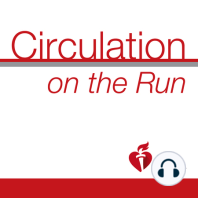16 min listen
Circulation June 04, 2019 Issue
ratings:
Length:
26 minutes
Released:
Jun 3, 2019
Format:
Podcast episode
Description
Dr Carolyn Lam: Welcome to Circulation on the Run, your weekly podcast summary and backstage pass to the journal and its editors. We're your co-hosts. I'm Dr Carolyn Lam, Associate Editor from the National Heart Center and Duke National University of Singapore. Dr Greg Hundley: I'm Greg Hundley, Associate Editor for Circulation and Director of the Pauley Heart Center in Richmond, Virginia at VCU Health. Dr Carolyn Lam: So Greg, ever wondered if prophylactic use of ICDs would help prevent sudden cardiac death in dialysis patients? Well, guess what? We're going to be discussing it in the feature discussion of the ICD II trial coming right up. First, I hear you've got a very interesting probabilistic paper. Dr Greg Hundley: Yes. It's very sweet. This is from Renata Micha at Tusk University and it's examining the cost effectiveness of the US Food and Drug Administration added sugar labeling policy for improving diet and health. So Carolyn, in this study, investigators used a validated micro simulation US impact food policy model to estimate cardiovascular disease and type II diabetes mellitus cases averted, quality adjusted life years, policy costs, health care, informal care, and loss productivity in health related savings and cost effectiveness of two different policy scenarios. First, the implementation of the US Food and Drug Administration added to your labeling policy or just the sugar label. And second, further accounting for corresponding industry reformulation the sugar label plus reformulation. The models used nationally represented demographic and dietary intake data from the national health and nutrition examinations survey and diseased data from the centers for disease control and preventive wonder data base and policy affects in diet disease effects from meta-analysis and policy and health related costs from established sources. Probabilistic sensitivity analysis accounted for model parameter uncertainties and population heterogeneity. Dr Carolyn Lam: Sweet indeed, so tell us all about probabilistic analysis Greg. Dr Greg Hundley: Okay Carolyn, so between 2018 and then forecasting out into the future, so this is probabilistic, in the year 2037. The sugar label would prevent 354,400 cardiovascular disease cases, and 599,300 diabetes mellitus cases, gain 727,000 quality adjusted life years, and save 31 Billion dollars in net health care costs. Or 61.9 Billion dollars in societal costs incorporating reduce loss productivity and informal care costs and similar findings were accomplished for the sugar label plus reformulation scenario, both scenarios were estimated with greater than 80% probability to be cost saving by the year 2023. Thus, the results of this simulation exercises indicated that implementing the FDAs added sugar labeling policy could generate substantial health gains and cost savings for the US population particularly if the new label stimulates industry reformulation. The authors point out that the compliance date for updating the nutrition facts label including the added sugar perversion has been continuously delayed. And the authors believe, their findings highlight the need for timely implementation of this label so as to maximize health and economic gains. An excellent editorial was written by Elizabeth Magnuson at Saint Luke's Mid America Heart Institute revealing the strengths of this work and explains some of the variants that could occur in the results based on assumptions that were used in the authors micro simulation model. Dr Carolyn Lam: That is so interesting Greg, thanks. So from policy to guidelines and this time on cardiopulmonary resuscitation or CPR, now we know that an out of hospital cardiac arrest, chest compression only CPR has emerged as an alt
Released:
Jun 3, 2019
Format:
Podcast episode
Titles in the series (100)
Circulation August 30, 2016 Issue: Circulation Weekly: Your Weekly Summary & Backstage Pass To The Journal by Circulation on the Run
